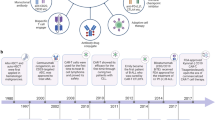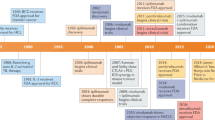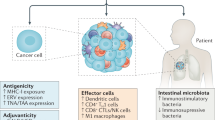Abstract
In advanced cancer, current conventional therapies or immunotherapies cannot eradicate all tumor cells for most patients. Integration of these two treatments for synergistic effects could eradicate more tumor cells and increase the overall survival rates. However, since how conventional treatments impact on immune system remains unclear, proper integration is still a challenge. Intensive chemo/radiotherapy may impair ongoing immune responses, while lower intensity of therapy might not kill enough tumor cells, both leading to tumor relapse. Current understanding of mechanisms of resistance to conventional and targeted cancer therapies has focused on cell intrinsic pathways that trigger DNA damage/repair or signaling pathways related to cell growth. Recent reports show that host T cells properly primed against tumor-specific antigens after conventional treatment, which can integrate with direct cytotoxic effects induced by radiation or chemotherapy to profoundly control tumors. Following cytotoxic anticancer treatment, tumor-derived DAMPs (damage-associated molecular patterns) can be sensed by innate cells, which drives type I interferon production for cross-priming of CD8+ T cells. Some types and protocols of chemotherapy or radiation can increase tumor-infiltrating lymphocytes that overcome resistance to immunotherapy. As such, a deeper understanding of the immune mechanisms of conventional and targeted cancer therapies will lead toward novel combinatorial anticancer strategies with improved clinical benefit.
This is a preview of subscription content, access via your institution
Access options
Subscribe to this journal
Receive 50 print issues and online access
$259.00 per year
only $5.18 per issue
Buy this article
- Purchase on Springer Link
- Instant access to full article PDF
Prices may be subject to local taxes which are calculated during checkout



Similar content being viewed by others
References
Hong WK, Hait WN, Kufe DW, Pollock RE, Weichselbaum RR, Holland JF . Emil Frei III Cancer Medicine, 8th edn. People’s Medical Publishing House: Shelton, CT, USA, 2010.
Topalian SL, Hodi FS, Brahmer JR, Gettinger SN, Smith DC, McDermott DF et al. Safety, activity, and immune correlates of anti-PD-1 antibody in cancer. N Engl J Med 2012; 366: 2443–2454.
Larkin J, Hodi FS, Wolchok JD . Combined nivolumab and ipilimumab or monotherapy in untreated melanoma. N Engl J Med 2015; 373: 1270–1271.
Kelland L . The resurgence of platinum-based cancer chemotherapy. Nat Rev Cancer 2007; 7: 573–584.
Prise KM, O'Sullivan JM . Radiation-induced bystander signalling in cancer therapy. Nat Rev Cancer 2009; 9: 351–360.
Llovet JM, Villanueva A, Lachenmayer A, Finn RS . Advances in targeted therapies for hepatocellular carcinoma in the genomic era. Nat Rev Clin Oncol 2015; 12: 436.
Casares N, Pequignot MO, Tesniere A, Ghiringhelli F, Roux S, Chaput N et al. Caspase-dependent immunogenicity of doxorubicin-induced tumor cell death. J Exp Med 2005; 202: 1691–1701.
Lee Y, Auh SL, Wang Y, Burnette B, Meng Y, Beckett M et al. Therapeutic effects of ablative radiation on local tumor require CD8+ T cells: changing strategies for cancer treatment. Blood 2009; 114: 589–595.
Park S, Jiang Z, Mortenson ED, Deng L, Radkevich-Brown O, Yang X et al. The therapeutic effect of anti-HER2/neu antibody depends on both innate and adaptive immunity. Cancer Cell 2010; 18: 160–170.
Zitvogel L, Galluzzi L, Kepp O, Smyth MJ, Kroemer G . Type I interferons in anticancer immunity. Nat Rev Immunol 2015; 15: 405–414.
Deng L, Liang H, Fu S, Weichselbaum RR, Fu YX, From DNA . Damage to nucleic acid sensing: a strategy to enhance radiation therapy. Clin Cancer Res 2015.
Salama JK, Hasselle MD, Chmura SJ, Malik R, Mehta N, Yenice KM et al. Stereotactic body radiotherapy for multisite extracranial oligometastases: final report of a dose escalation trial in patients with 1 to 5 sites of metastatic disease. Cancer 2012; 118: 2962–2970.
Westover KD, Iyengar P, Sharma AN, Timmerman R . SABR for aggressive local therapy of metastatic cancer: a new paradigm for metastatic non-small cell lung cancer. Lung Cancer 2015; 89: 87–93.
Reits EA, Hodge JW, Herberts CA, Groothuis TA, Chakraborty M, Wansley EK et al. Radiation modulates the peptide repertoire, enhances MHC class I expression, and induces successful antitumor immunotherapy. J Exp Med. 2006; 203: 1259–1271.
Chakraborty M, Abrams SI, Coleman CN, Camphausen K, Schlom J, Hodge JW . External beam radiation of tumors alters phenotype of tumor cells to render them susceptible to vaccine-mediated T-cell killing. Cancer Res 2004; 64: 4328–4337.
Ganss R, Ryschich E, Klar E, Arnold B, Hammerling GJ . Combination of T-cell therapy and trigger of inflammation induces remodeling of the vasculature and tumor eradication. Cancer Res 2002; 62: 1462–1470.
Lugade AA, Moran JP, Gerber SA, Rose RC, Frelinger JG, Lord EM . Local radiation therapy of B16 melanoma tumors increases the generation of tumor antigen-specific effector cells that traffic to the tumor. J Immunol 2005; 174: 7516–7523.
Gallucci S, Lolkema M, Matzinger P . Natural adjuvants: endogenous activators of dendritic cells. Nat Med 1999; 5: 1249–1255.
Apetoh L, Ghiringhelli F, Tesniere A, Obeid M, Ortiz C, Criollo A et al. Toll-like receptor 4-dependent contribution of the immune system to anticancer chemotherapy and radiotherapy. Nat Med 2007; 13: 1050–1059.
Formenti SC, Demaria S . Combining radiotherapy and cancer immunotherapy: a paradigm shift. J Natl Cancer Inst 2013; 105: 256–265.
Gameiro SR, Jammeh ML, Wattenberg MM, Tsang KY, Ferrone S, Hodge JW . Radiation-induced immunogenic modulation of tumor enhances antigen processing and calreticulin exposure, resulting in enhanced T-cell killing. Oncotarget 2014; 5: 403–416.
Krysko DV, Garg AD, Kaczmarek A, Krysko O, Agostinis P, Vandenabeele P . Immunogenic cell death and DAMPs in cancer therapy. Nat Rev Cancer 2012; 12: 860–875.
Kroemer G, Galluzzi L, Kepp O, Zitvogel L . Immunogenic cell death in cancer therapy. Annu Rev Immunol 2013; 31: 51–72.
Schaue D, Ratikan JA, Iwamoto KS, McBride WH . Maximizing tumor immunity with fractionated radiation. Int J Radiat Oncol Biol Phys 2012; 83: 1306–1310.
Lee Y, Auh SL, Wang Y, Burnette B, Wang Y, Meng Y et al. Therapeutic effects of ablative radiation on local tumor require CD8+ T cells: changing strategies for cancer treatment. Blood 2009; 114: 589–595.
Dovedi SJ, Melis MH, Wilkinson RW, Adlard AL, Stratford IJ, Honeychurch J et al. Systemic delivery of a TLR7 agonist in combination with radiation primes durable antitumor immune responses in mouse models of lymphoma. Blood 2013; 121: 251–259.
Gandhi SJ, Minn AJ, Vonderheide RH, Wherry EJ, Hahn SM, Maity A . Awakening the immune system with radiation: optimal dose and fractionation. Cancer Lett 2015; 368: 185–190.
Meacham CE, Morrison SJ . Tumour heterogeneity and cancer cell plasticity. Nature 2013; 501: 328–337.
Aguirre-Ghiso JA . Models, mechanisms and clinical evidence for cancer dormancy. Nat Rev Cancer 2007; 7: 834–846.
Goss PE, Chambers AF . Does tumour dormancy offer a therapeutic target? Nat Rev Cancer 2010; 10: 871–877.
Liang H, Deng L, Chmura S, Burnette B, Liadis N, Darga T et al. Radiation-induced equilibrium is a balance between tumor cell proliferation and T cell-mediated killing. J Immunol 2013; 190: 5874–5881.
Burnette BC, Liang H, Lee Y, Chlewicki L, Khodarev NN, Weichselbaum RR et al. The efficacy of radiotherapy relies upon induction of type i interferon-dependent innate and adaptive immunity. Cancer Res 2011; 71: 2488–2496.
Crouse J, Kalinke U, Oxenius A . Regulation of antiviral T cell responses by type I interferons. Nat Rev Immunol 2015; 15: 231–242.
Trinchieri G . Type I interferon: friend or foe? J Exp Med 2010; 207: 2053–2063.
Fuertes MB, Kacha AK, Kline J, Woo SR, Kranz DM, Murphy KM et al. Host type I IFN signals are required for antitumor CD8+ T cell responses through CD8{alpha}+ dendritic cells. J Exp Med 2011; 208: 2005–2016.
Diamond MS, Kinder M, Matsushita H, Mashayekhi M, Dunn GP, Archambault JM et al. Type I interferon is selectively required by dendritic cells for immune rejection of tumors. J Exp Med 2011; 208: 1989–2003.
Wu CY, Yang LH, Yang HY, Knoff J, Peng S, Lin YH et al. Enhanced cancer radiotherapy through immunosuppressive stromal cell destruction in tumors. Clin Cancer Res 2014; 20: 644–657.
Sun L, Wu J, Du F, Chen X, Chen ZJ . Cyclic GMP-AMP synthase is a cytosolic DNA sensor that activates the type I interferon pathway. Science 2013; 339: 786–791.
Zhang X, Shi H, Wu J, Sun L, Chen C, Chen ZJ . Cyclic GMP-AMP containing mixed phosphodiester linkages is an endogenous high-affinity ligand for STING. Mol Cell 2013; 51: 226–235.
Ahn GO, Tseng D, Liao CH, Dorie MJ, Czechowicz A, Brown JM . Inhibition of Mac-1 (CD11b/CD18) enhances tumor response to radiation by reducing myeloid cell recruitment. Proc Natl Acad Sci USA 2010; 107: 8363–8368.
Wu J, Chen ZJ . Innate immune sensing and signaling of cytosolic nucleic acids. Annu Rev Immunol 2014; 32: 461–488.
Gao D, Wu J, Wu YT, Du F, Aroh C, Yan N et al. Cyclic GMP-AMP synthase is an innate immune sensor of HIV and other retroviruses. Science 2013; 341: 903–906.
Ahn J, Gutman D, Saijo S, Barber GN . STING manifests self DNA-dependent inflammatory disease. Proc Natl Acad Sci USA 2012; 109: 19386–19391.
Woo SR, Fuertes MB, Corrales L, Spranger S, Furdyna MJ, Leung MY et al. STING-dependent cytosolic DNA sensing mediates innate immune recognition of immunogenic tumors. Immunity 2014; 41: 830–842.
Deng L, Liang H, Xu M, Yang X, Burnette B, Arina A et al. STING-dependent cytosolic DNA sensing promotes radiation-induced type I interferon-dependent antitumor immunity in immunogenic tumors. Immunity 2014; 41: 843–852.
Fu J, Kanne DB, Leong M, Glickman LH, McWhirter SM, Lemmens E et al. STING agonist formulated cancer vaccines can cure established tumors resistant to PD-1 blockade. Sci Transl Med 2015; 7: 283ra52.
Corrales L, Glickman LH, McWhirter SM, Kanne DB, Sivick KE, Katibah GE et al. Direct activation of STING in the tumor microenvironment leads to potent and systemic tumor regression and immunity. Cell Rep 2015; 11: 1018–1030.
Orr MT, Lanier LL . Natural killer cell education and tolerance. Cell 2010; 142: 847–856.
Gasser S, Orsulic S, Brown EJ, Raulet DH . The DNA damage pathway regulates innate immune system ligands of the NKG2D receptor. Nature 2005; 436: 1186–1190.
Gehrmann M, Marienhagen J, Eichholtz-Wirth H, Fritz E, Ellwart J, Jaattela M et al. Dual function of membrane-bound heat shock protein 70 (Hsp70), Bag-4, and Hsp40: protection against radiation-induced effects and target structure for natural killer cells. Cell Death Differ 2005; 12: 38–51.
Galluzzi L, Vacchelli E, Bravo-San Pedro JM, Buque A, Senovilla L, Baracco EE et al. Classification of current anticancer immunotherapies. Oncotarget 2014; 5: 12472–12508.
Abes R, Gelize E, Fridman WH, Teillaud JL . Long-lasting antitumor protection by anti-CD20 antibody through cellular immune response. Blood 2010; 116: 926–934.
Garg AD, Galluzzi L, Apetoh L, Baert T, Birge RB, Bravo-San Pedro JM et al. Molecular and translational classifications of DAMPs in immunogenic cell death. Front Immunol 2015; 6: 588.
Obeid M, Tesniere A, Ghiringhelli F, Fimia GM, Apetoh L, Perfettini JL et al. Calreticulin exposure dictates the immunogenicity of cancer cell death. Nat Med 2007; 13: 54–61.
Garg AD, Krysko DV, Verfaillie T, Kaczmarek A, Ferreira GB, Marysael T et al. A novel pathway combining calreticulin exposure and ATP secretion in immunogenic cancer cell death. EMBO J. 2012; 31: 1062–1079.
Martins I, Tesniere A, Kepp O, Michaud M, Schlemmer F, Senovilla L et al. Chemotherapy induces ATP release from tumor cells. Cell Cycle 2009; 8: 3723–3728.
Michaud M, Martins I, Sukkurwala AQ, Adjemian S, Ma Y, Pellegatti P et al. Autophagy-dependent anticancer immune responses induced by chemotherapeutic agents in mice. Science 2011; 334: 1573–1577.
Jube S, Rivera ZS, Bianchi ME, Powers A, Wang E, Pagano I et al. Cancer cell secretion of the DAMP protein HMGB1 supports progression in malignant mesothelioma. Cancer Res 2012; 72: 3290–3301.
Zitvogel L, Kepp O, Senovilla L, Menger L, Chaput N, Kroemer G . Immunogenic tumor cell death for optimal anticancer therapy: the calreticulin exposure pathway. Clin Cancer Res 2010; 16: 3100–3104.
Haynes NM, van der Most RG, Lake RA, Smyth MJ . Immunogenic anti-cancer chemotherapy as an emerging concept. Curr Opin Immunol 2008; 20: 545–557.
Suzuki Y, Mimura K, Yoshimoto Y, Watanabe M, Ohkubo Y, Izawa S et al. Immunogenic tumor cell death induced by chemoradiotherapy in patients with esophageal squamous cell carcinoma. Cancer Res 2012; 72: 3967–3976.
Liu R, Gong J, Chen J, Li Q, Song C, Zhang J et al. Calreticulin as a potential diagnostic biomarker for lung cancer. Cancer Immunol Immunother 2012; 61: 855–864.
Sistigu A, Yamazaki T, Vacchelli E, Chaba K, Enot DP, Adam J et al. Cancer cell-autonomous contribution of type I interferon signaling to the efficacy of chemotherapy. Nat Med 2014; 20: 1301–1309.
Hartlova A, Erttmann SF, Raffi FA, Schmalz AM, Resch U, Anugula S et al. DNA damage primes the type I interferon system via the cytosolic DNA sensor STING to promote anti-microbial innate immunity. Immunity 2015; 42: 332–343.
Zelenay S, Reis e Sousa C . Adaptive immunity after cell death. Trends Immunol 2013; 34: 329–335.
Biswas S, Guix M, Rinehart C, Dugger TC, Chytil A, Moses HL et al. Inhibition of TGF-beta with neutralizing antibodies prevents radiation-induced acceleration of metastatic cancer progression. J Clin Invest 2007; 117: 1305–1313.
Baselga J, Albanell J . Mechanism of action of anti-HER2 monoclonal antibodies. Ann Oncol 2001; 12 ((Suppl 1)): S35–S41.
Baselga J . The EGFR as a target for anticancer therapy—focus on cetuximab. Eur J Cancer 2001; 37 ((Suppl 4)): S16–S22.
Arnould L, Gelly M, Penault-Llorca F, Benoit L, Bonnetain F, Migeon C et al. Trastuzumab-based treatment of HER2-positive breast cancer: an antibody-dependent cellular cytotoxicity mechanism? Br J Cancer 2006; 94: 259–267.
Benavides LC, Gates JD, Carmichael MG, Patil R, Holmes JP, Hueman MT et al. The impact of HER2/neu expression level on response to the E75 vaccine: from U.S. Military Cancer Institute Clinical Trials Group Study I-01 and I-02. Clin Cancer Res 2009; 15: 2895–2904.
Cartron G, Watier H, Golay J, Solal-Celigny P . From the bench to the bedside: ways to improve rituximab efficacy. Blood 2004; 104: 2635–2642.
Stagg J, Loi S, Divisekera U, Ngiow SF, Duret H, Yagita H et al. Anti-ErbB-2 mAb therapy requires type I and II interferons and synergizes with anti-PD-1 or anti-CD137 mAb therapy. Proc Natl Acad Sci USA 2011; 108: 7142–7147.
Yang X, Zhang X, Mortenson ED, Radkevich-Brown O, Wang Y, Fu YX . Cetuximab-mediated tumor regression depends on innate and adaptive immune responses. Mol Ther 2013; 21: 91–100.
Correale P, Botta C, Cusi MG, Del Vecchio MT, De Santi MM, Gori Savellini G et al. Cetuximab +/− chemotherapy enhances dendritic cell-mediated phagocytosis of colon cancer cells and ignites a highly efficient colon cancer antigen-specific cytotoxic T-cell response in vitro. Int J Cancer 2012; 130: 1577–1589.
Clynes RA, Towers TL, Presta LG, Ravetch JV . Inhibitory Fc receptors modulate in vivo cytotoxicity against tumor targets. Nat Med 2000; 6: 443–446.
Minard-Colin V, Xiu Y, Poe JC, Horikawa M, Magro CM, Hamaguchi Y et al. Lymphoma depletion during CD20 immunotherapy in mice is mediated by macrophage FcgammaRI, FcgammaRIII, and FcgammaRIV. Blood 2008; 112: 1205–1213.
Uchida J, Hamaguchi Y, Oliver JA, Ravetch JV, Poe JC, Haas KM et al. The innate mononuclear phagocyte network depletes B lymphocytes through Fc receptor-dependent mechanisms during anti-CD20 antibody immunotherapy. J Exp Med 2004; 199: 1659–1669.
Roghanian A, Teige I, Martensson L, Cox KL, Kovacek M, Ljungars A et al. Antagonistic human FcgammaRIIB (CD32B) antibodies have anti-tumor activity and overcome resistance to antibody therapy in vivo. Cancer Cell 2015; 27: 473–488.
Lim SH, Vaughan AT, Ashton-Key M, Williams EL, Dixon SV, Chan HT et al. Fc gamma receptor IIb on target B cells promotes rituximab internalization and reduces clinical efficacy. Blood 2011; 118: 2530–2540.
Liu J, Wang L, Zhao F, Tseng S, Narayanan C, Shura L et al. Pre-clinical development of a humanized anti-CD47 antibody with anti-cancer therapeutic potential. PLoS One 2015; 10: e0137345.
DiLillo DJ, Ravetch JV . Differential Fc-receptor engagement drives an anti-tumor vaccinal effect. Cell 2015; 161: 1035–1045.
Chao MP, Alizadeh AA, Tang C, Myklebust JH, Varghese B, Gill S et al. Anti-CD47 antibody synergizes with rituximab to promote phagocytosis and eradicate non-Hodgkin lymphoma. Cell 2010; 142: 699–713.
Majeti R, Chao MP, Alizadeh AA, Pang WW, Jaiswal S, Gibbs KD Jr et al. CD47 is an adverse prognostic factor and therapeutic antibody target on human acute myeloid leukemia stem cells. Cell 2009; 138: 286–299.
Liu X, Pu Y, Cron K, Deng L, Kline J, Frazier WA et al. CD47 blockade triggers T cell-mediated destruction of immunogenic tumors. Nat Med 2015; 21: 1209–1215.
Rafiq K, Bergtold A, Clynes R . Immune complex-mediated antigen presentation induces tumor immunity. J Clin Invest. 2002; 110: 71–79.
Kurts C, Robinson BW, Knolle PA . Cross-priming in health and disease. Nat Rev Immunol 2010; 10: 403–414.
Yang X, Zhang X, Fu ML, Weichselbaum RR, Gajewski TF, Guo Y et al. Targeting the tumor microenvironment with interferon-beta bridges innate and adaptive immune responses. Cancer Cell 2014; 25: 37–48.
Acknowledgements
This work was, in part, supported by US National Institutes of Health Grants CA141975 (to Y-XF), a grant from the Ludwig Foundation (to RRW) and a generous gift from The Foglia Foundation (to Y-XF and RRW).
Author information
Authors and Affiliations
Corresponding authors
Ethics declarations
Competing interests
The authors declare no conflict of interest.
Rights and permissions
About this article
Cite this article
Michelle Xu, M., Pu, Y., Weichselbaum, R. et al. Integrating conventional and antibody-based targeted anticancer treatment into immunotherapy. Oncogene 36, 585–592 (2017). https://doi.org/10.1038/onc.2016.231
Received:
Revised:
Accepted:
Published:
Issue Date:
DOI: https://doi.org/10.1038/onc.2016.231
This article is cited by
-
Targeting innate sensing in the tumor microenvironment to improve immunotherapy
Cellular & Molecular Immunology (2020)
-
Cryo-thermal therapy induces macrophage polarization for durable anti-tumor immunity
Cell Death & Disease (2019)



